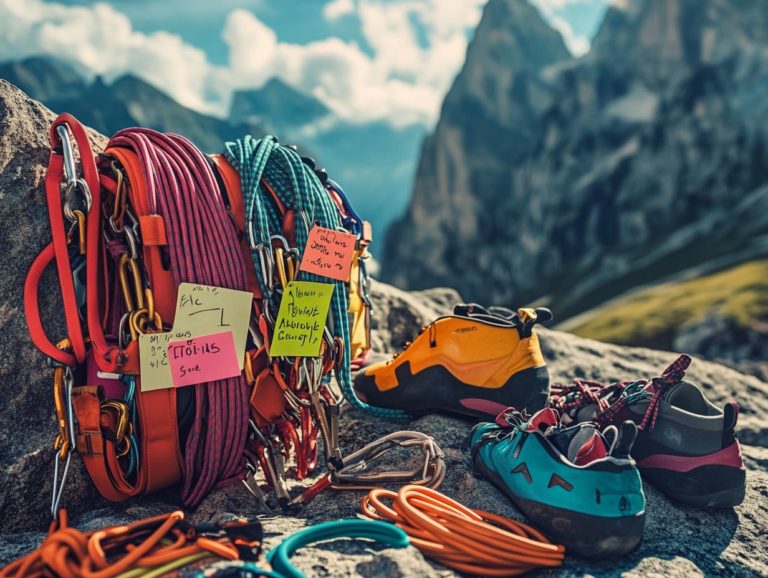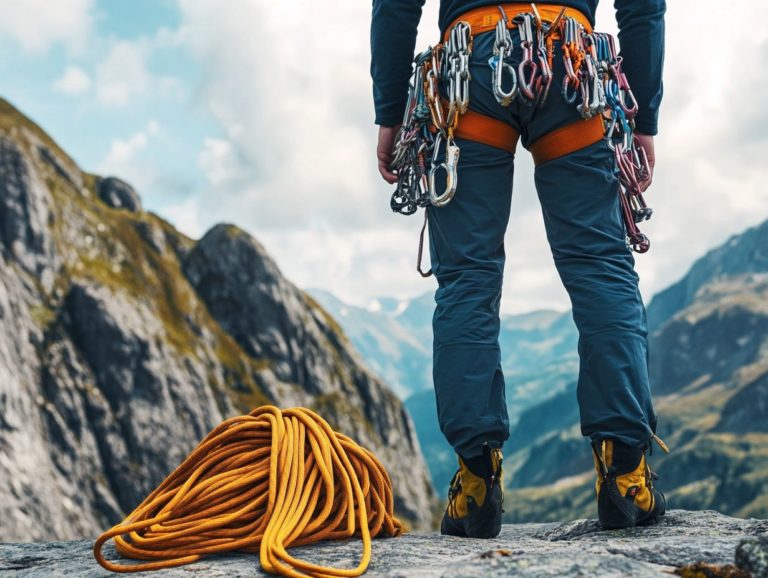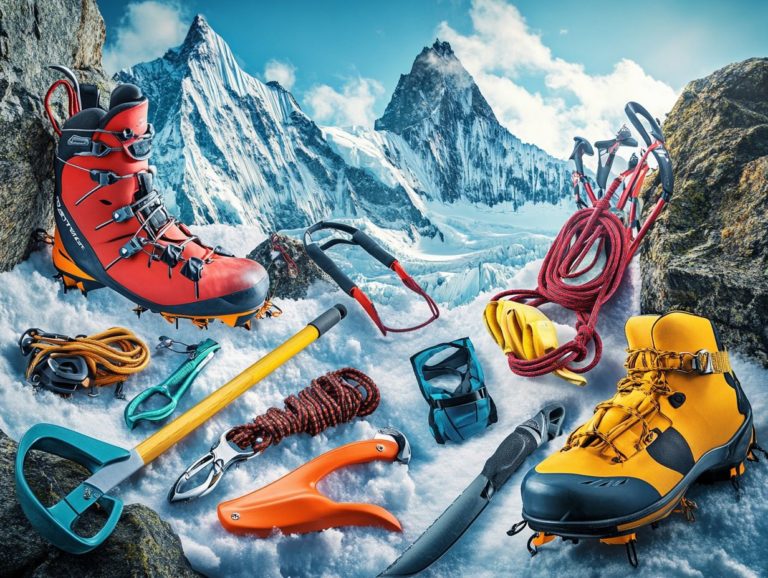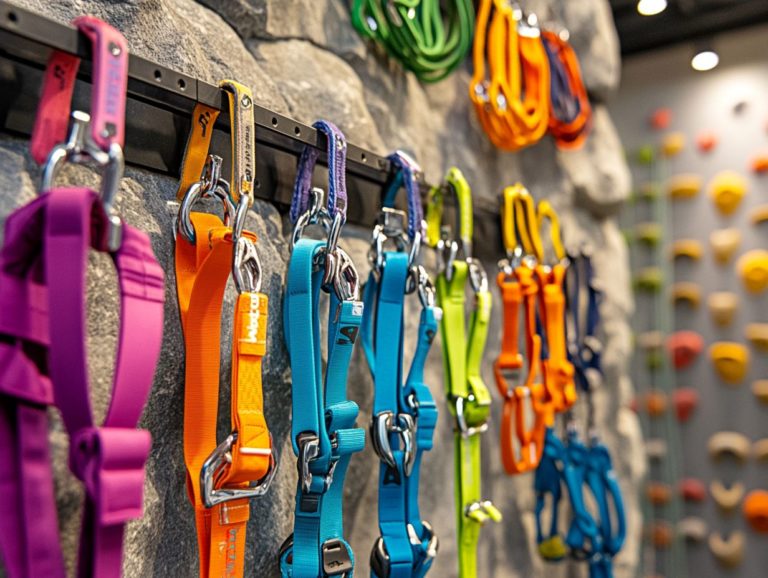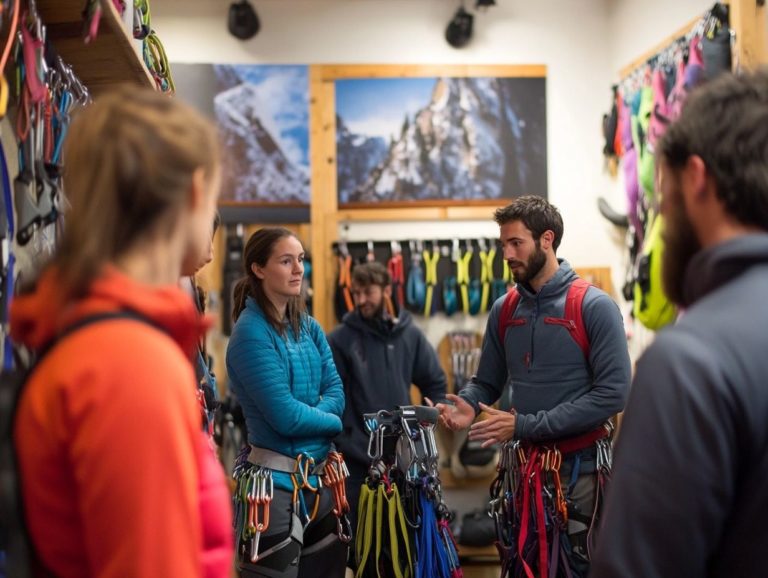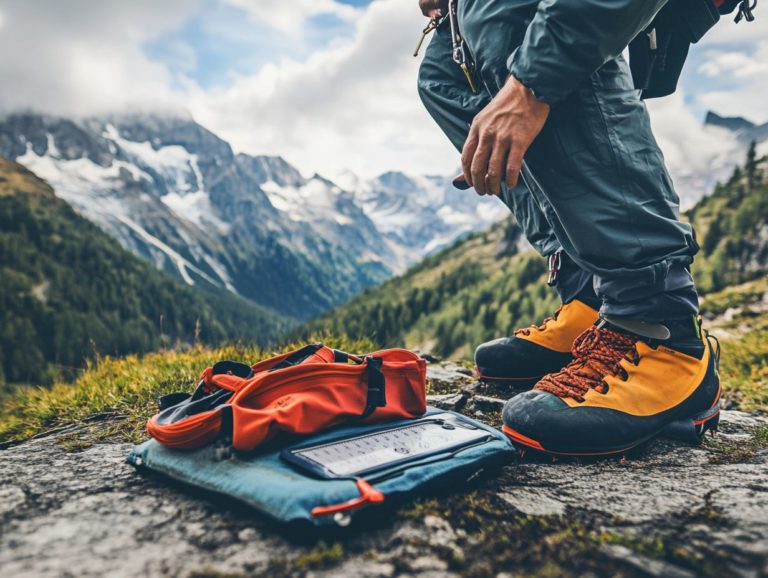The Future of Climbing Gear Technology
Climbing gear has evolved dramatically. It has transformed from basic tools into advanced equipment that enhances performance and safety.
Explore the current landscape of climbing gear technology. Discover the latest gear types and their specific functions, as well as advancements in materials and designs that improve climbers’ experiences.
Look ahead to future technologies and their potential. Consider the challenges of sustainability and cost that the industry faces.
Get ready to explore the exciting future of climbing gear!
Contents
- Key Takeaways:
- Evolution of Climbing Gear
- Current State of Climbing Gear Technology
- Advancements in Climbing Gear Technology
- Potential Future Developments
- Challenges in Advancing Climbing Gear Technology
- Frequently Asked Questions
- What is the current state of climbing gear technology?
- What can we expect to see in the future of climbing gear technology?
- Will climbing gear technology make climbing easier?
- How will climbing gear technology impact the environment?
- Can beginners benefit from climbing gear technology?
- What role do climbers play in the future of climbing gear technology?
Key Takeaways:

- Climbing gear technology is constantly evolving with new materials and designs that improve performance and safety.
- Technologies like smart fabrics and 3D printing could greatly impact the future of climbing gear.
- Balancing sustainability and cost is crucial for advancing climbing gear technology and ensuring accessibility for all.
Evolution of Climbing Gear
The evolution of climbing gear has changed significantly. It has shifted from simple tools to highly specialized products that enhance your performance and safety.
Today’s gear integrates advanced materials, smart training tools, and features like customizable auto belay systems. These innovations cater to a diverse climbing community while ensuring your security.
Companies like Petzl and Wild Country are leading the way. They continuously push the limits of climbing technology to serve both professional climbers and recreational enthusiasts.
Current State of Climbing Gear Technology
The current landscape of climbing gear technology is marked by seamless innovation. Smart climbing walls and intuitive equipment elevate your experience, whether at the gym or outdoors.
Brands such as TRUBLUE and Griptonite are pioneers in offering customizable options. This lets you enjoy safer and more efficient training sessions while overcoming operational challenges in climbing facilities.
Types of Gear and Their Functions
Climbing gear encompasses a diverse range of equipment. Each piece is designed for specific functions that enhance safety and performance for climbers of all levels.
Essential items include carabiners, quickdraws, harnesses, and crash pads. These tools help you navigate various terrains and tackle climbing challenges confidently.
Belay devices and climbing ropes are crucial for managing the forces experienced during falls. Modern ropes come in types that balance stretch and durability.
Lightweight helmets provide extra protection from overhead hazards. Specialized climbing shoes enhance grip and fit, making every step on rocky surfaces more secure.
Innovations in gear boost your confidence and reduce risks. This allows you to focus on perfecting your techniques and enjoying thrilling outdoor adventures.
Advancements in Climbing Gear Technology
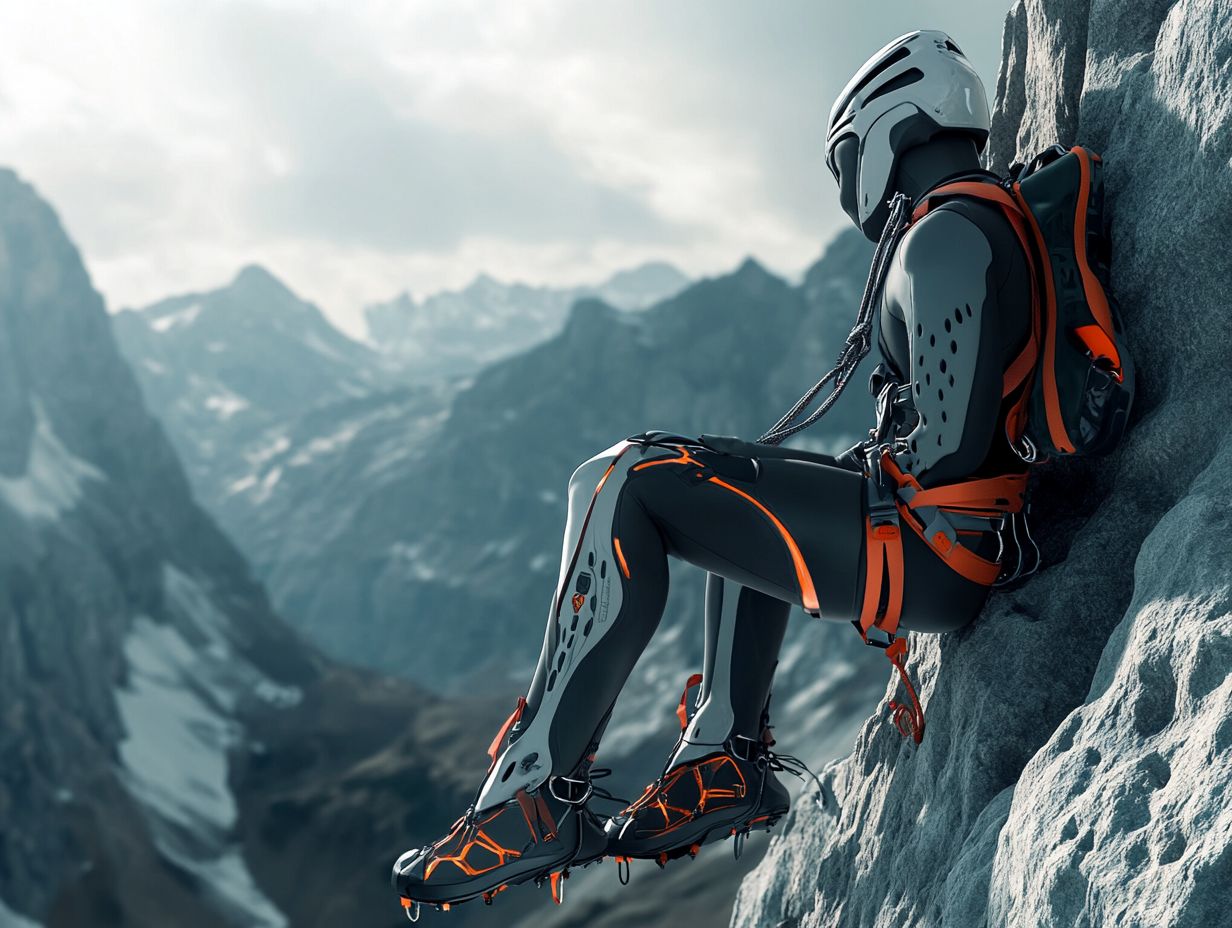
Climbing gear technology has transformed the industry. New products prioritize your safety while enhancing performance tracking and usability.
Eco-designed harnesses and smart training tools showcase how climbing innovations improve your experience. These advancements also address environmental concerns, promoting sustainability in climbing.
New Materials and Designs
New materials in climbing gear help manufacturers create products that are lighter, stronger, and more durable, which boosts your climbing performance.
These innovations offer customizable options to fit your needs, ensuring your equipment is functional and aligns with your personal preferences and safety requirements.
Advancements in technologies like carbon fiber composites and high-tenacity nylon have transformed harnesses and ropes. They are now resilient and responsive to various climbing conditions.
You benefit from features like improved breathability and moisture-wicking capabilities in clothing, significantly enhancing your comfort during long ascents.
Safety devices, including advanced belay systems that use cutting-edge braking technologies, give you extra assurance and reduce the likelihood of accidents.
The thoughtful integration of these materials boosts your overall performance while minimizing gear weight, allowing you to tackle challenging terrains with confidence and ease.
Impact on Performance and Safety
Advancements in climbing gear drastically improve your performance and safety.
Innovations like biometric data tracking (monitoring your body data) and enhanced safety features have transformed how you approach climbing activities and competitions.
With improved safety protocols, you can focus on pushing your limits, confident that your gear is reliable and meets the highest performance standards.
This cutting-edge equipment boosts your confidence and optimizes your performance metrics by enabling real-time monitoring of your heart rate and muscle tension through integrated sensors.
As you navigate challenging routes, these technologies provide crucial insights, allowing you to adjust your strategies and effort levels seamlessly.
Competitions now showcase climbing gear that enhances safety and allows you to analyze your performance data after each climb, paving the way for continuous improvement.
By bridging the gap between technology and traditional climbing practices, these advancements enable you to leverage data-driven strategies to excel in your climbing endeavors.
Potential Future Developments
The climbing industry is evolving rapidly. Future developments will bring exciting changes through the integration of AI-powered applications and virtual reality environments.
These innovations are set to enhance your training and engagement as a climber.
Imagine immersive experiences that provide personalized insights, significantly improving your skills, safety, and overall enjoyment of the sport.
The future of climbing is not just about reaching new heights; it’s about elevating your entire experience.
Emerging Technologies and Their Potential Uses
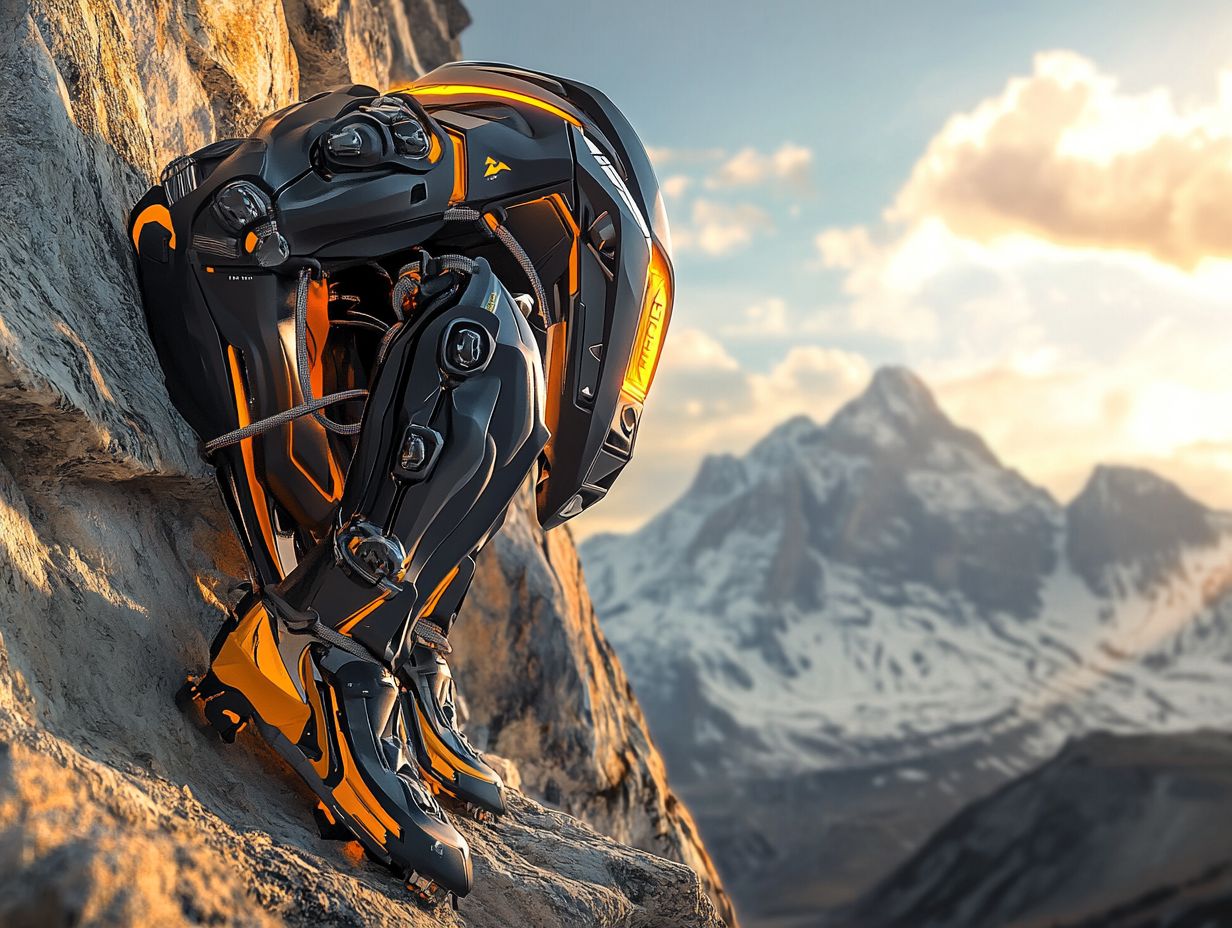
Emerging technologies are changing how you train and experience events. Smart training tools now offer personalized feedback and performance tracking, allowing you to optimize your training regime and prepare effectively for climbing events.
This means you can enhance your overall performance while minimizing the risks associated with the sport.
Innovative advancements like augmented reality (AR) (a technology that overlays digital information on the real world) and wearable devices are becoming essential in the climbing community.
Imagine using AR to simulate various climbing routes, allowing you to practice and visualize your techniques without needing actual outdoor conditions.
Meanwhile, wearables can monitor your vital stats, providing real-time data that helps you adjust your efforts and avoid injuries.
Virtual coaching platforms are also a game-changer, connecting you with experienced trainers from around the globe and fostering a supportive environment for skill enhancement.
These tech solutions motivate you and create a more interactive and engaging experience during competitions, paving the way for a new era in climbing sports.
Challenges in Advancing Climbing Gear Technology
Despite remarkable advancements in climbing gear technology, several challenges still persist, especially regarding sustainability and cost considerations in product development.
Climbing manufacturers face dual pressure: they must innovate while ensuring their gear adheres to safety standards and meets the climbing community’s increasing demand for environmentally friendly options. Insights from the medical advisory board also play a crucial role in this process. For those interested in the latest advancements, the top 5 Crux climbing gear innovations highlight how brands are rising to these challenges without sacrificing affordability.
Sustainability and Cost Considerations
Sustainability and cost considerations are essential factors in the climbing gear industry. Brands strive to create environmentally friendly harnesses and equipment that resonate with your values as a climber.
By balancing innovation and environmental responsibility, companies can cater to your demands and preserve the climbing environment for future generations.
As awareness of climate change and environmental degradation grows, you likely prioritize products that align with your commitment to sustainability. This shift influences your purchasing decisions and encourages manufacturers to adopt sustainable practices, from sourcing materials responsibly to minimizing waste.
The connection between a brand s environmental efforts and your loyalty is becoming increasingly clear. As a climber, you tend to favor gear that boasts eco-friendly certifications. While cost is always a factor, you re willing to invest in high-quality, durable equipment that minimizes long-term environmental impact. This proves that sustainable choices and economic considerations can coexist in the marketplace, reflecting a shared commitment to a healthier planet.
Predictions and Possibilities
Predictions for the future of climbing gear technology indicate a growing trend toward integrating smart features and enhancing community engagement. This ushers in a new era for climbers like you.
Imagine wearing amazing sensors that give you real-time data on your movements and performance, allowing you to personalize your training regimen. Picture augmented reality applications guiding you through routes, overlaying vital information directly into your field of vision!
Collaborations among gear manufacturers, tech companies, and climbing gyms could lead to workshops and community events, bridging the gap between seasoned experts and newcomers. This collaborative spirit would promote greater accessibility and inclusivity, ensuring that your future climbing experiences are about more than just conquering peaks they’re about building lasting friendships and enriching the sport as a whole.
Frequently Asked Questions

What is the current state of climbing gear technology?
Currently, climbing gear technology is continuously evolving and becoming more advanced. Manufacturers are developing and improving gear to make it safer, more durable, and more efficient for climbers.
What can we expect to see in the future of climbing gear technology?
In the future, we can expect to see more innovative gear, such as self-belaying devices (devices that automatically manage your safety rope), lightweight and durable materials, and advanced tracking and navigation systems.
Will climbing gear technology make climbing easier?
While climbing gear technology can make certain aspects of climbing easier, it ultimately depends on the skill and technique of the climber. However, advanced gear can provide added safety and convenience for climbers.
How will climbing gear technology impact the environment?
Climbing gear technology is becoming more environmentally friendly, with the use of sustainable materials and production methods. This helps reduce the impact of gear manufacturing on the environment.
Can beginners benefit from climbing gear technology?
Absolutely! Beginners can benefit from advancements in climbing gear technology, as they can make the learning process safer and more efficient. However, it is still important to learn proper climbing techniques and safety protocols.
We’d love to hear your thoughts! Share your experiences with climbing gear technology below!
What role do climbers play in the future of climbing gear technology?
Climbers play an exciting part in shaping the future of climbing gear technology.
Their feedback and input drive the development of gear. This ensures it meets the needs of climbers.

